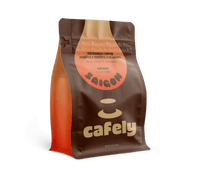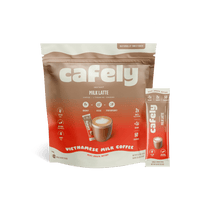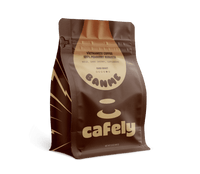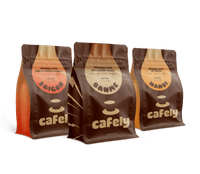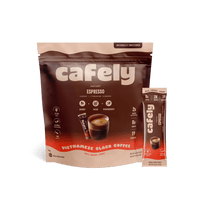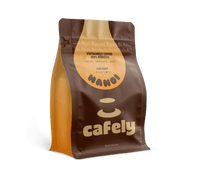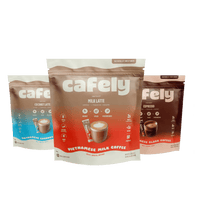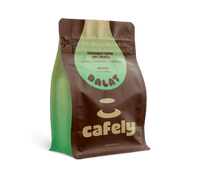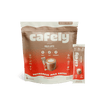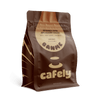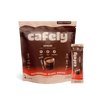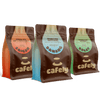An espresso is only as good as the coffee you make it with, whether you prefer a strong, bold flavor or a smooth, balanced profile. Our guide covers how to find the best coffee for your espresso and includes our top picks from Cafely.
Top Recommendations: Best Coffee for Espresso

- BanMe Coffee (100% peaberry robusta) — For a strong caffeine punch.
- HaNoi Coffee (100% robusta) — For full-bodied flavors and high caffeine intensity.
- SaiGon OG (robusta + arabica + peaberry) — For a smooth and flavorful blend that’s still strong.
- DaNang Coffee (50% robusta, 50% arabica) — For a silky smooth and rich morning cup of espresso.
- DaLat Coffee (100% arabica) — For lower caffeine content but still with a traditional smooth finish.
Best Grind Size for Espresso
Selecting the correct grind size is one of the most important stages in making espresso at home. For the perfect silky smooth espresso, you need a fine grind. Here’s why.
Why Does Grind Size Matter?
If the grind size is too large, the water passes through the grounds too easily, and you end up with no flavor in your brew. Espresso machines use tamping and a lot of pressure to force the water through the coffee, so you need a fine grind to ensure you get bold flavor in every sip.
On the other hand, if the grind size is too small, you might end up overextracting the coffee, which will make the flavor more acidic and bitter-tasting.
Achieving the Perfect Grind
If you want to achieve the perfect grind size but don’t have a grinder at home, you can always buy pre-ground beans. The benefit of this is that they’ll be professionally ground, so it should be consistent. However, you’ll need to make sure it’s finely ground; ground coffee from the store is usually too coarse for espresso. The other drawback is the longer your coffee is ground, the less flavor it has.
As grinding your beans at home provides the freshest and purest flavor profile, we’d recommend investing in a burr grinder. These are more reliable and consistent, but they can be pricey. However, the upside is that you can grind to different specificities for different coffee makers and you can have the freshest coffee possible.
Best Roast for Espresso
One of the biggest things that can alter the taste of your espresso is the roast.
Realistically, you want a dark roast to bring out smooth, rich, and deep flavors that we traditionally associate with espressos.
Of course, this is personal preference, so you might enjoy the more floral, subtle notes of a light roast more, but if you’re looking for that classic espresso profile, stick with dark roasts.
Best Bean Type for Espresso

The main two types of coffee beans are robusta and arabica. There are significant differences between them, so you might prefer one over the other or opt for a blend of the two.
There are a few main differences between arabica and robusta:
- Arabica has a much smoother and fruitier flavor compared to robusta’s rich, intense flavor.
- Robusta has about twice the amount of caffeine as arabica.
While the intense and rich flavors of robusta are great for the full-bodied vibe of espresso, the smooth finish that comes with arabica works well for it. A lot of the time, it’s a good idea to get a blend of the two for the best of both worlds. But again, this comes down to personal preference.
Best Origin for Espresso
Another factor that impacts the taste of your morning shot of espresso is the origin of the coffee. Things like soil quality, the amount of rain, and the methods used in the harvesting process all alter the flavor profile of coffee.
If you’re looking for a consistent flavor in your espresso, opt for single-origin coffee. This means that all the beans are grown in the same place, in the same batch, and by the same producer.
The PH of the soil can also impact whether a bean is more acidic or sweeter in its taste profile. There’s a reason why certain places are more suited to robusta or arabica beans, and it has to do with the soil and climate.
Coffee plants grow best in temperate or tropical environments and love volcanic or sandy and silty soil. The hill country of Vietnam is the largest producer of robusta in the world because of its ideal conditions.
Related: History of Vietnamese Coffee
Espresso Brewing Techniques
So, how do you brew the perfect espresso? Get your coffee beans and follow these steps:
- Warm up your espresso machine
- Measure & finely grind your coffee
- Prepare & tamp your portafilter
- Brew your espresso
- Evaluate your shot. Dial & pour another one if needed
Top Tips:
Make sure not to over-tamp your portafilter in stage three, as this might lead to over-extraction, which will make your espresso more acidic and bitter. Go for a solid one-tamp instead.
Water temperature plays a key role in the quality of the shot. Some machines allow you to adjust the temperature, so aim for 200°F (93°C).
Pairing Espresso With Food
If you’re looking for something to eat with your espresso, consider rich foods like dark chocolate and peanut butter. These rich but slightly bitter and salty flavors perfectly complement the intense notes in the espresso.
In more of a savory mood? Bacon or grilled cheese works well, as they’re still rich but have a saltiness that enhances the espresso flavor.
FAQs: Espresso Coffee
Okay, now that you know everything about picking the right coffee for your espresso, let’s round things out with some frequently asked questions.
1. What is the best grind size for espresso?
The best grind size for espresso is fine. You want a coffee ground that resembles table salt or caster sugar.
2. Can I use robusta beans for espresso?
Yes, you can use robusta beans for espresso. They provide strong flavor and rich crema with a high caffeine content — ideal for sleepy mornings. In fact, robusta is often recommended as one of the best coffee selections to stay awake, thanks to its bold taste and significantly higher caffeine levels compared to arabica.
3. How can I avoid a bitter espresso?
You can avoid a bitter espresso by using fresh beans and the proper grind size, and you can avoid over-extraction with excess tamping.
4. What makes a good espresso blend?
A good espresso blend should be a balance of strength, flavor, and crema, often using a mix of robusta and arabica beans for the ultimate espresso experience.
5. How often should I clean my espresso machine?
You should clean your espresso machine after each use and thoroughly clean it once a month.
6. What is the ideal water temperature for brewing espresso?
The ideal water temperature for brewing espresso is between 195°F and 205°F (90°C to 96°C).
7. Can I use pre-ground coffee for espresso?
Yes, you can use pre-ground coffee for espresso. However, freshly ground beans are better as they have a fresher flavor profile.
8. What is crema, and why is it important?
The crema is the golden-brown foam on top, indicating a well-extracted espresso. If your espresso doesn’t have crema, consider redialing your machines and coffee ratios and pulling it through again.
9. How can I improve the flavor of my espresso?
You can improve the flavor of your espresso by using fresh beans, properly grinding them, and maintaining your espresso-making equipment.
10. What are the health benefits of drinking espresso?
Espresso does have some health benefits — as long as the sugar and fat content don’t outweigh the positives. In moderation, coffee can be good for you since it contains antioxidants and can improve concentration, mood, and energy.
